1996 CADILLAC SEVILLE power steering
[x] Cancel search: power steeringPage 39 of 354
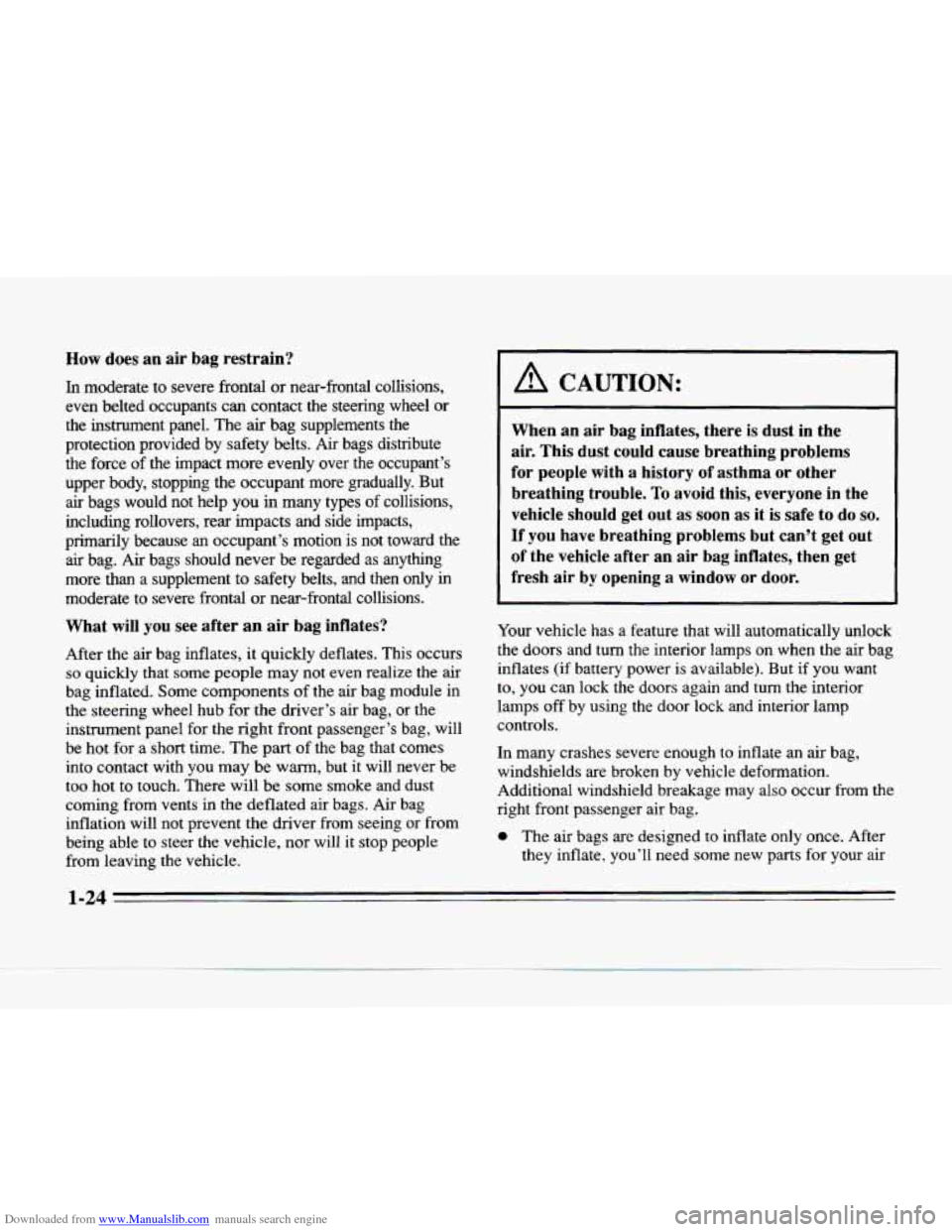
Downloaded from www.Manualslib.com manuals search engine How does an air bag restrain?
In moderate to severe frontal or near-frontal collisions,
even belted occupants can contact the steering wheel or
the instrument panel. The air bag supplements the
protection provided by safety belts.
Air bags distribute
the force of the impact more evenly over the occupant’s
upper body, stopping the occupant more gradually.
But
air bags would not help you in many types of collisions,
including rollovers, rear impacts and side impacts,
primarily because
an occupant’s motion is not toward the
air bag. Air bags should never be regarded as anything
more than
a supplement to safety belts, and then only in
moderate to severe frontal or near-frontal collisions.
What will you see after an air bag inflates?
After the air bag inflates, it quickly deflates. This occurs
so quickly that some people may not even realize the air
bag inflated. Some components
of the air bag module in
the steering wheel hub for
the driver’s air bag, or the
instrument panel for the right front passenger’s bag, will
be hot for a short time. The part
of the bag that comes
into contact with you
may be warm, but it will never be
too hot to touch. There will be some smoke and dust
coming from vents in the deflated air bags. Air bag
inflation will not prevent the driver from seeing or from
being able to steer the vehicle, nor will it stop people
from leaving the vehicle.
~
A CAUTION:
When an air bag inflates, there is dust in the
air. This dust could cause breathing problems
for people with a history of asthma
or other
breathing trouble.
To avoid this, everyone in the
vehicle should get out as soon as it is safe to do
so.
If you have breathing problems but can’t get out
of the vehicle after an air bag inflates, then get
fresh air by opening
a window or door.
Your vehicle has a feature that will automatically unlock
the doors
and turn the interior lamps on when the air bag
inflates
(if battery power is available). But if you want
to, you can lock the doors again and turn the interior
lamps
off by using the door lock and interior lamp
controls.
In many crashes severe enough
to inflate an air bag,
windshields are broken by vehicle deformation.
Additional windshield breakage may also occur
from the
right front passenger air bag.
0 The air bags are designed to inflate only once. After
they inflate, you’ll need
some new parts for your air
-24
Page 71 of 354
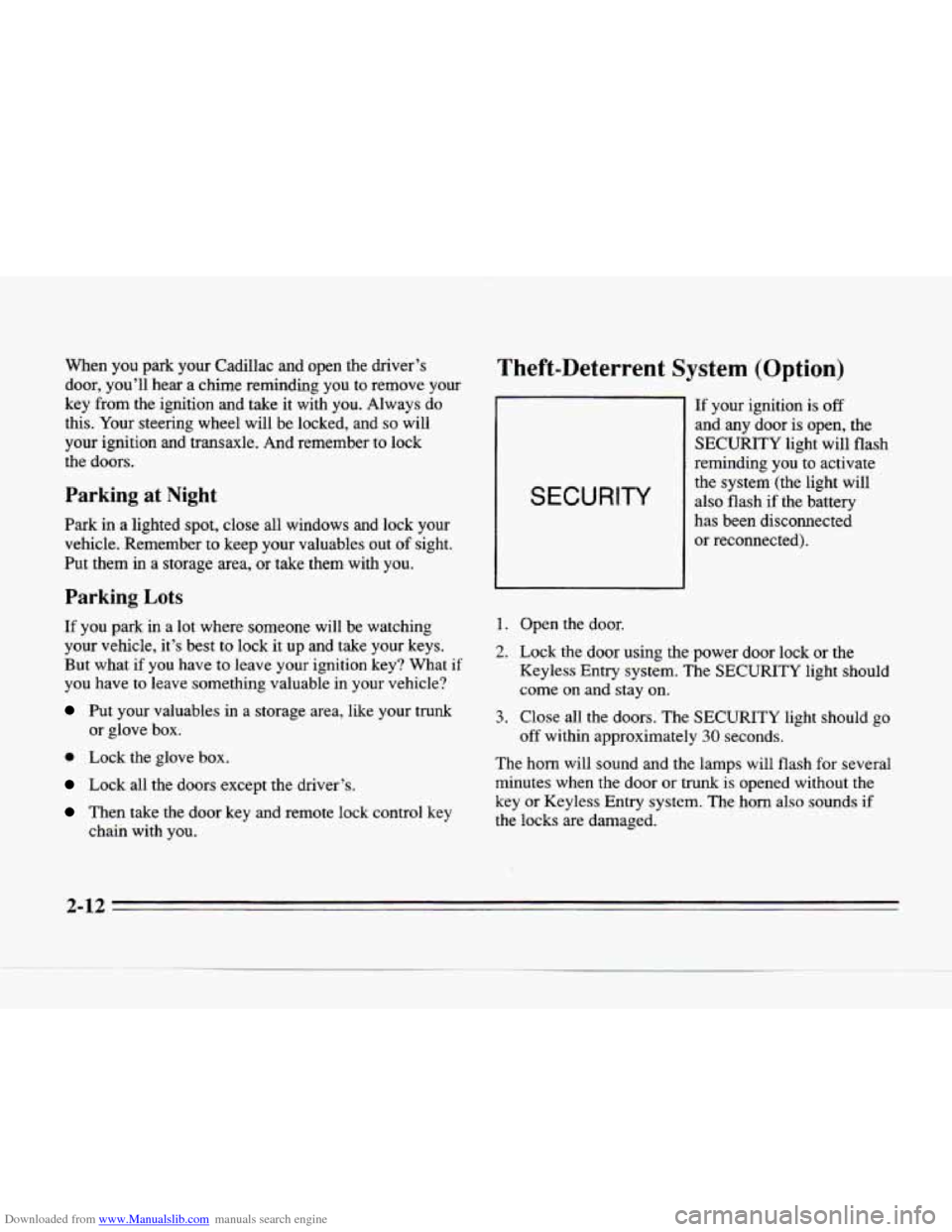
Downloaded from www.Manualslib.com manuals search engine When you park your Cadillac and open the driver’s
door, you’ll hear a chime reminding you to remove your
key
from the ignition and take it with you. Always do
this. Your steering wheel will be locked, and
so will
your ignition and transaxle. And remember
to lock
the doors.
Parking at Night
Park in a lighted spot, close all windows and lock your
vehicle. Remember to keep your valuables out
of sight.
Put them
in a storage area, or take them with you.
Parking Lots
If you park in a lot where someone will be watching
your vehicle, it’s best
to lock it up and take your keys.
But what if you have to leave your ignition key? What if
you have to leave something valuable in your vehicle?
Put your valuables in a storage area, like your trunk
0 Lock the glove box.
Lock all the doors except the driver’s.
Then take the door key and remote lock control key
or glove box.
chain with you.
Theft-Deterrent System (Option)
SECURITY
If your ignition is off
and any door is open, the
SECURITY light will flash
reminding you to activate
the system (the light will
also flash if the battery
has been disconnected
or reconnected).
1. Open the door.
2. Lock the door using the power door lock or the
Keyless Entry system. The SECURITY light should
come on and stay on.
3. Close all the doors. The SECURITY light should go
off within approximately 30 seconds.
The horn will sound and the lamps will flash for several
minutes when the door
or trunk is opened without the
key or Keyless Entry system. The horn also sounds if
the locks are damaged.
2-12 .- -
Page 193 of 354

Downloaded from www.Manualslib.com manuals search engine Braking in Emergencies .
Us& ptxr anti-lock braking system when you need to.
With anti-lock,
you can steer and brake at the same
time. In
many emergencies, steering can help you more
than even the very best braking.
Steering
Power Steering
If you lose power steering assist because the engine
stops or the system is not functioning, you can steer but
it will take much more effort.
MAGNASTEER (STS Only)
Your vehicle may be equipped with GM MAGNASTEER,
a system that continuously adjusts the effort you feel when
steering at
all vehicle speeds. It provides ease when
parking yet
a fm, solid feel at highway speeds.
Speed Sensitive Steering (SSS) (SLS Only)
This system varies the amount of steering effort
proportionate to your vehicle speed. Steering
is easier at
a lower speed for maneuvering and parking ease‘.
As
your vehicle speed increases, the steering effort also
increases.
At highway speeds, the amount of steering
effort is increased to provide manual-like steering for
maximum control and stability.
Steering Tips
Driving on Curves
It’s important to take curves at a reasonable speed.
A lot of the “driver lost control” accidents mentioned on
the news happen on curves. Here’s
why:
Experienced driver or beginner, each of us is subject to
the same laws of physics when driving on curves. The
traction
of the tires against the road surface makes it
possible for the vehicle to change its
path when you turn
the front wheels. If there’s no traction, inertia will keep
the vehicle going in the same direction.
If you’ve ever
tried
to steer a vehicle on wet ice, you’ll understand this.
4-10
Page 267 of 354
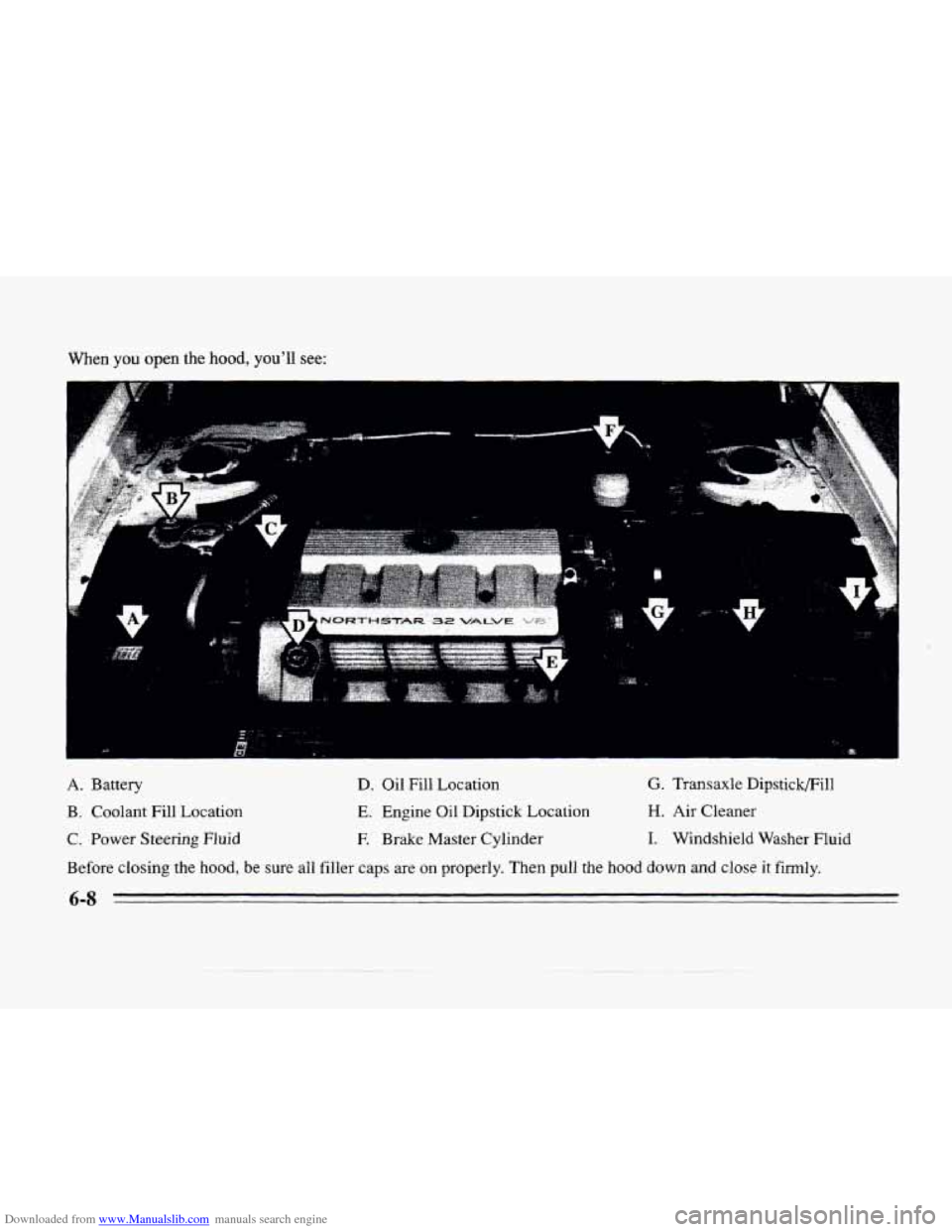
Downloaded from www.Manualslib.com manuals search engine When you open the hood, you'll see:
.. .
A. Battery D. Oil Fill Location G. Transaxle Dipstick/Fill
B. Coolant Fill Location
E. Engine Oil Dipstick Location H. Air Cleaner
C. Power Steering Fluid E Brake Master Cylinder I. Windshield Washer Fluid
Before closing the hood, be sure all filler caps are on properly. Then
pull the hood down and close it firmly.
6-8
Page 283 of 354

Downloaded from www.Manualslib.com manuals search engine Power Steering Fluid
The power steering fluid
reservoir
is located next to
the coolant surge tank on
the passenger’s side
of
When to Check Power Steering Fluid
It is not necessary to regularly check power steering
fluid unless you suspect there is a leak in the system or
you hear
an unusual noise. A fluid loss in this system
could indicate
a problem. Have the system inspected
and repaired.
How To Check Power Steering Fluid
When the engine compartment is cool, unscrew the cap
and wipe the dipstick with a clean rag. Replace the cap
and completely tighten it. Then remove the cap again
and look at the fluid level
on the dipstick.
The level should be
at the FULL COLD mark. If
necessary, add only enough fluid to bring the level up to
the mark.
What to Use
Refer to the Maintenance Schedule to determine what
kind of fluid to use. See “Recommended Fluids and
Lubricants” in the Maintenance Schedule booklet.
Always use the proper fluid. Failure to use the proper
fluid can cause leaks and damage hoses and seals.
Windshield Washer Fluid
What to Use
When you need windshield washer fluid, be sure to read
the manufacturer’s instructions before use.
If you will be
operating your vehicle in an area where the temperature
may fall below freezing, use a fluid that has sufficient
protection against freezing.
6-24
Page 316 of 354
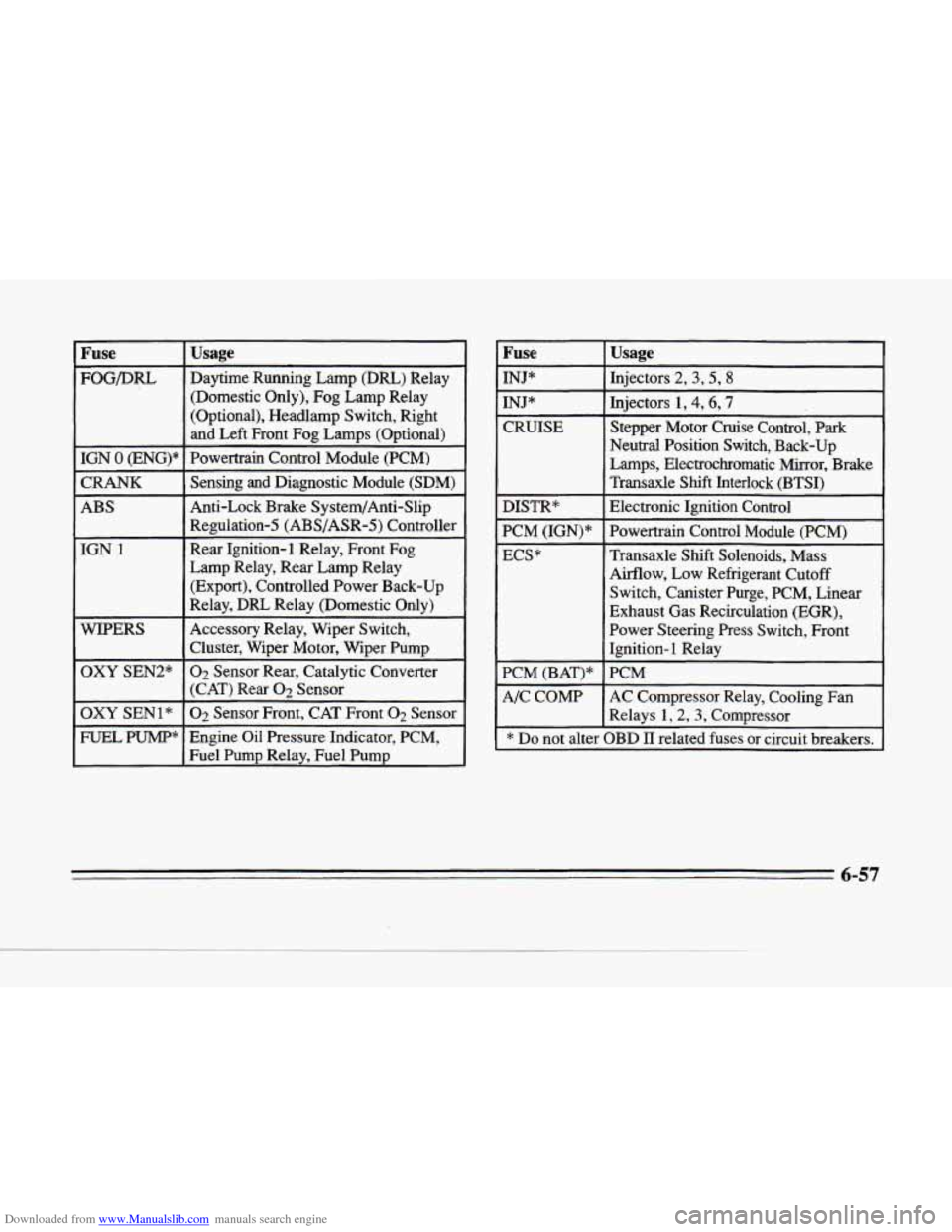
Downloaded from www.Manualslib.com manuals search engine -
Usage
Fuse Fuse
FOG/DRL
Usage
Daytime Running Lamp (DRL) Relay
(Domestic Only),
Fog Lamp Relay
(Optional), Headlamp Switch, Right
and Left Front Fog Lamps (Optional)
~~ ~
Injectors 2,3,5,8
INJ* Injectors 1,4,6,7 -
Stepper Motor Cruise Control, Park
Neutral Position Switch, Back-up
Lamps, Electrochromatic Mirror, Brake
Transaxle Shift Interlock (BTSI)
CRUISE
I IGN 0 (ENG)* I Powertrain
Control Module (PCM) I
I CRANK I Sensing and Diagnostic Module (SDM) I - ~~
Electronic Ignition Control
I ABS I Regulation-5 (ABS/ASR-5) Controller I
Anti-Lock Brake System/Anti-Slip DISTR*
PCM (IGN)" ~
Powertrain
Control Module (PCM)
Transaxle Shift Solenoids, Mass
Airflow, Low Refrigerant Cutoff
Switch, Canister Purge, PCM, Linear
Exhaust
Gas Recirculation (EGR),
Power Steering Press Switch, Front
Ignition-
1 Relay
Rear
Ignition-1 Relay, Front Fog
Lamp Relay, Rear Lamp Relay
(Export), Controlled Power Back-up
Relay,
DRL Relay (Domestic Only)
IGN
1 ECS*
I I Cluster, Wiper
Motor, Wiper Pump I
Accessory Relay, Wiper Switch,
I
OXY SEN2* 02 Sensor Rear, Catalytic Converter
I (CAT) Rear Op Sensor I
-
PCM PCM (BAT)*
A/C COMP AC Compressor Relay, Cooling Fan
Relays
1,2,3, Compressor OXY SEN1 *
Engine Oil Pressure Indicator, PCM, FUEL PUMP"
02 Sensor Front, CAT Front 02 Sensor
Fuel Pump Relax Fuel PumD
* Do not alter OBD I1 related fuses or circuit breakers.
6-57
Page 320 of 354

Downloaded from www.Manualslib.com manuals search engine c
Fuse
Module (RIM)(Bose Only),
PHONE Radio
Receiver, Radio Interface
RADIO/
Usage
Phone, DAB Relay, Trunk Release
Relay, Fuel Door Release Relay,
High Beam Relay
CLUSTER Steering
Wheel Controls, Cluster
ACC PZM,
Electrochromic Mirror,
Rain Sensor (Optional),
Accessory Relay
RR DEFOG Rear
Defog
HTD
MIR Right and Left Outside
Heated Mirror
HTD SEAT R Passenger Heated Seat Relay
HTD
SEAT L Driver
Heated Seat Relay
PULL
DOWN
ELC Relay and motor ELC
Trunk Pull-Down Motor
Headlamp Wash Relay (Export),
HDLP WASH Power
Mast Antenna
ANTENNA
Headlamp Wash Motor
Fuse
CONVENC
BATT
RTD
RT PARK
LT PARK
Usage
Trunk Release Relay, Trunk
Release Solenoid, Fuel Door .
Release Relay, Fuel Filler Door
Release Solenoid, Door Lock
Relay, Right and Left Front Door
Motors, Right and Left Rear Door
Motors, Door Unlock Relay
Driver and Passenger Seat Lumbar
Switch, Lumbar Switch (Driver
Seat Only), Memory Seat Module
RTD Module
Front and Rear Park Lamps, Right
Front
and Rear Sidemarker
Lamps, Headlamp Switch
(Export), Rear Fog Lamp Relay
(Export), Headlamp Switch
Left Front
and Rear Sidemarker
Lamps, Right
and Left Parking
Lamps, License Lamp,
Underhood Lamp
* Do not alter OBD II related fuses or circuit breakers.
~~
Page 342 of 354
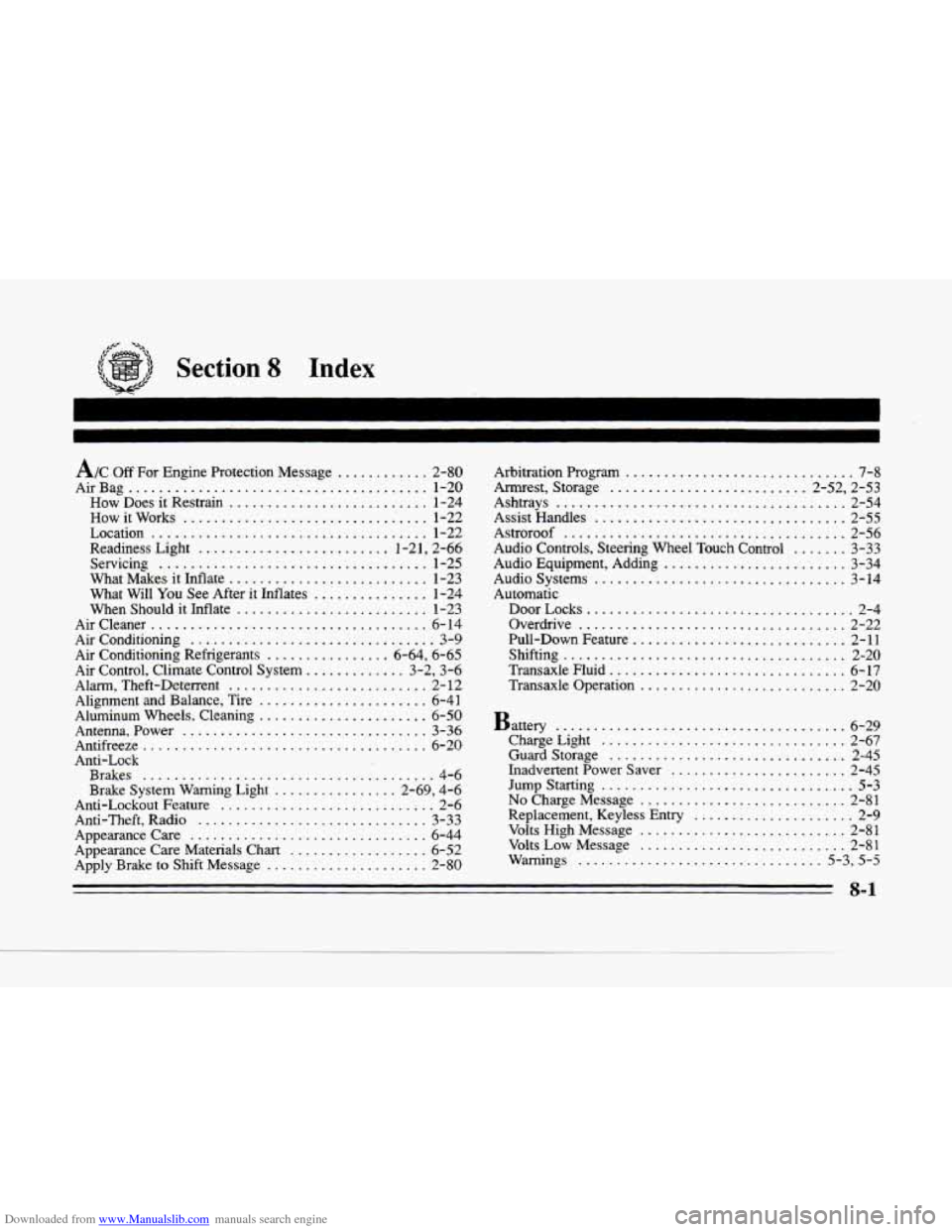
Downloaded from www.Manualslib.com manuals search engine Section 8 Index
.
Y
..
.
A/C Off For Engine Protection Message ............ 2-80
AirBag
....................................... 1-20
How Does it Restrain
.......................... 1-24
How it Works
................................ 1-22
Location
.................................... 1-22
Readiness Light
......................... 1.21. 2.66
Servicing
................................... 1-25
What Makes it Inflate
.......................... 1-23
What Will
You See After it Inflates ............... 1-24
When Should it Inflate ......................... 1-23
Aircleaner
.................................... 6-14
Air Conditioning
................................ 3-9
Air Conditioning Refrigerants ................ 6.64. 6.65
Air Control
. Climate Control System ............. 3.2. 3-6
Alarm. Theft-Deterrent .......................... 2-12
Alignment and Balance. Tire
...................... 6-41
Aluminum Wheels
. Cleaning ...................... 6-SO
Antenna. Power
................................ 3-36
Antifreeze ..................................... 6-20
Anti-Lock Brakes
...................................... 4-6
Brake System Warning Light
................ 2.69. 4.6
Anti-Lockout Feature
............................ 2-6
Anti.Theft. Radio
.............................. 3-33
Appearance Care
............................... 6-44
Appearance Care Materials Chart
.................. 6-52
Apply Brake to
Shift Message ..................... 2-80 Arbitration Program
.............................. 7-8
Armrest. Storage
.......................... 2.52. 2.53
Ashtrays
...................................... 2-54
Assist Handles
................................. 2-55
Astroroof
..................................... 2-56
Audio Controls. Steering Wheel Touch Control
....... 3-33
Audio Equipment. Adding
........................ 3-34
Audio Systems
................................. 3-14
Automatic DoorLocks
................................... 2-4
Overdrive
................................... 2-22
Pull-Down Feature
............................ 2-11
Shifting
..................................... 2-20
Transaxle Fluid
............................... 6-17
Transaxle Operation
........................... 2-20
Battery
...................................... 6-29
ChargeLight
................................ 2-67
Guard Storage
............................... 2-45
Inadvertent Power Saver
....................... 2-45
Jump Starting ................................. 5-3
No
Charge Message ........................... 2-81
Replacement. Keyless Entry
..................... 2-9
Volts High Message
........................... 2-81
Volts Low Message
........................... 2-81
Warnings
................................ 5-3. 5-5
8-1